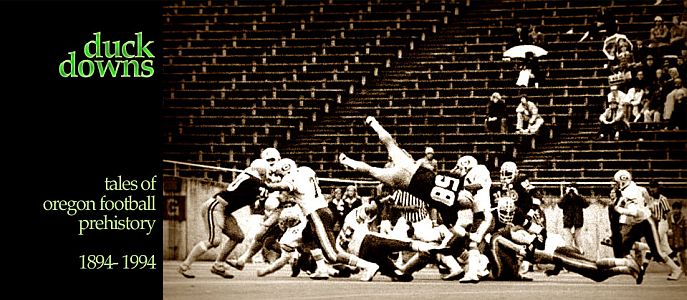October 12, 1957: San Jose State at Oregon
 September 22, 2011
September 22, 2011 In Oregon’s first Rose Bowl season since 1920, the big story of mid-October wasn’t the heady play of the Oregon backfield. It was the controversy caused by the disclosure that admission standards at Oregon for out-of-state students were being raised without regard for the needs of the athletic department. Up the road, OAC did not differentiate between locals and imports with regard to qualifications, and as a result the Beavers were said to be poaching athletes – primarily football and baseball players – who wanted to attend Oregon but couldn’t qualify, because of an arbitrary decision by the admissions department. This, as could be expected, did not sit well with the alumni, nor with local scribes:
“.. in addition to the loss of university prestige and the revenue needed to make the athletic department self-sustaining, there is always the matter of putting the coaches in the position of playing in a highly competitive league without the tools to compete. In view of the high caliber of men currently coaching the Oregon teams, it seems unfair to handicap them in this matter.” – Dick Strite, sports editor, Eugene Register-Guard
The admissions department eventually backed down after negotiations with UO president Meredith Wilson.
The ’57 Ducks didn’t do a lot of backing down on the field. Coming into week 4 off a shutout of UCLA, and with their only loss to a Pitt team that went on to whip USC and blow out Nebraska, Len Casanova’s best team so far had only allowed 12 points over three games. For the first of only three games in Eugene that season, the townies were treated to a puff pastry in San Jose State. The passing attack that would prove so effective later in the season had yet to be fully developed, and the Webfoots ground out a 26-0 victory with a decidedly unbalanced attack – 59 runs and 11 passes. But two of Oregon’s four touchdowns came via air; one from halfback Charley Tourville to a wide-open Jim Shanley for 16 yards, the other a two-yard flip from QB Jack Crabtree to end Jay Wheeler, after Shanley opened the 2nd half with a sensational 61-yard kickoff return. Shanley added a 58 yard run off tackle, and nose tackle Bob Peterson blocked a SJS punt into the end zone and recovered for the game’s final score.
Later, in a season where Washington, UCLA and USC were declared ineligible for the various hijinks that eventually led to the distintegration of the old PCC, Oregon beat USC 16-7 behind the then-record 211 rushing yards of Jack Morris in its penultimate regular-season contest to clinch a tie for the conference title. The Webfoots lost the ’57 Civil War, but earned the Rose Bowl bid anyway thanks to a no-repeat clause, OSC having won the 1956 title.
Program Notes –
- The generic covers by “R. Vrooman” continue, with costly period oils and watercolors eschewed for something you could slap on the front of a thirty-five cent magazine. This cover appears on several other college programs of the period.
- The advertising mix is interesting: KitchenAid dishwashers, Lady Sunbeam Shavemasters, Longines wristwatches spoke to an odd demographic. Maybe the publishers thought the ladies would be spending more time staring at the program than at the action – and, judging by the Cracker Jack ad, where the girl is staring at the prize while the guy watches the action on the field, they might have been onto something.
- Going along with the apparent appeal to the distaff fan, page 18 has an un-bylined feature, “Try Something New”, that implores the reader to “take your attention off the ball carrier for a couple of plays and watch some particular lineman do his job” for a “new football thrill.” It’s non-generic, current (“the replacements have come along nicely and have helped ably in each of the first three games”) and well written.
- For once something other than tobacco shares the color sections, with only the center roster spread and back cover bearing cigarette ads.






